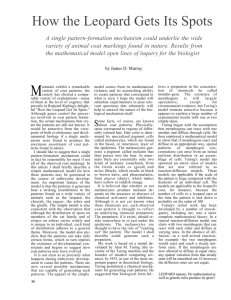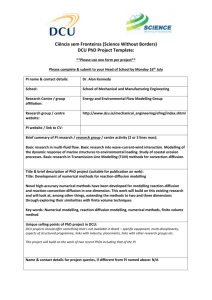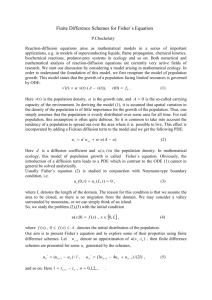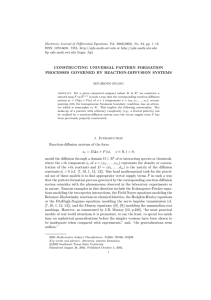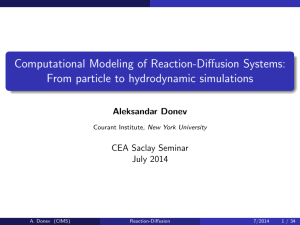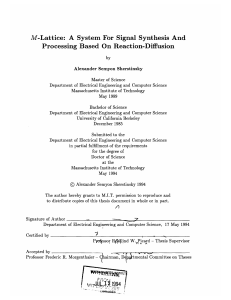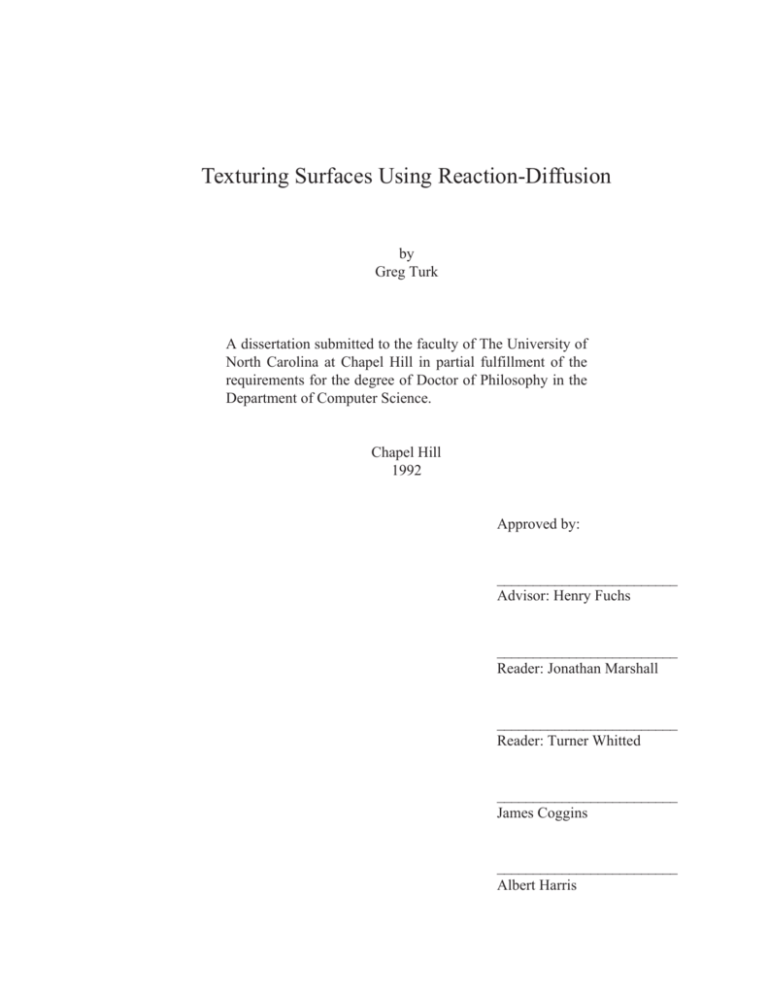
Texturing Surfaces Using Reaction-Diffusion
by
Greg Turk
A dissertation submitted to the faculty of The University of
North Carolina at Chapel Hill in partial fulfillment of the
requirements for the degree of Doctor of Philosophy in the
Department of Computer Science.
Chapel Hill
1992
Approved by:
_________________________
Advisor: Henry Fuchs
_________________________
Reader: Jonathan Marshall
_________________________
Reader: Turner Whitted
_________________________
James Coggins
_________________________
Albert Harris
© 1992
Greg Turk
ALL RIGHTS RESERVED
GREG TURK. Texturing Surfaces Using Reaction-Diffusion (under the direction of Henry
Fuchs).
Abstract
This dissertation introduces a new method of creating computer graphics textures that is
based on simulating a biological model of pattern formation known as reaction-diffusion.
Applied mathematicians and biologists have shown how simple reaction-diffusion systems
can create patterns of spots or stripes. Here we demonstrate that the range of patterns created
by reaction-diffusion can be greatly expanded by cascading two or more reaction-diffusion
systems. Cascaded systems can produce such complex patterns as the clusters of spots found
on leopards and the mixture of spots and stripes found on certain squirrels.
This dissertation also presents a method for simulating reaction-diffusion systems directly on
the surface of any given polygonal model. This is done by creating a mesh for simulation that
is specifically fit to a particular model. Such a mesh is created by first randomly distributing
points over the surface of the model and causing these points to repel one another so that they
are evenly spaced over the surface. Then a mesh cell is created around each point by finding
the Voronoi region for each point within a local planar approximation to the surface.
Reaction-diffusion systems can then be simulated on this mesh of cells. The chemical
concentrations resulting from such a simulation can be converted to color values to create a
texture. Textures created by simulation on a mesh do not have the problems of texture
distortion or seams between patches that are artifacts of some other methods of texturing.
Two methods of rendering these synthetic textures are presented. The first method uses a new
surface of triangles that closely matches the original model, but whose vertices are taken from
the cells of the simulation mesh. These vertices are assigned colors based on the simulation
values, and this re-tiled model can be rapidly displayed on a graphics workstation. A higherquality image can be created by computing each pixel’s color value using a weighted average
of the chemical concentration at nearby mesh points. Using a smooth cubic weighting
function gives a satisfactory reconstruction of the underlying function specified by the values
at the mesh points. Several low-pass filtered versions of the texture are used to avoid aliasing
when the textured object covers a small portion of the screen. The proper color value at a pixel
is found by selecting from the appropriately filtered level.
- iii -
Acknowledgments
I thank Henry Fuchs for giving me the freedom and the encouragement to pursue the research
that led to this dissertation. I am grateful for the guidance that Albert Harris gave to me about
issues in developmental biology and for the many pleasant conversations we had on the
subject. I thank Turner Whitted for his advice on technical issues in computer graphics,
especially during the critical time when I was first preparing an article about this work. I also
thank James Coggins and Jonathan Marshall for their excellent suggestions for improving
this dissertation.
I thank the many friends that have offered help and encouragement. In particular I thank
David Banks, David Ellsworth, Steve Molnar, Carl Mueller, Marc Olano, Mark Parris, Penny
Rheingans, and Brice Tebbs. These are the people that made my years at UNC a joy.
I thank Mary McFarlane for the love and patience she has shown through the often difficult
process of finishing this dissertation.
Finally, I thank my parents for the love, understanding and encouragement that they have
shown throughout my education.
- iv -
Figure Credits
Some of the figures in this dissertation were made with the generous help of others. I thank
all of them.
Special thanks are due to Marc Olano, Carl Mueller, and Andrei State for helping me during
the last few weeks before my defense. Marc Olano created Figures 1.6, 1.7, and 1.8. Carl
Mueller made Figures 1.2, 1.4, 1.5, 5.7, 5.8, and 5.9. Figure 2.1 was drawn by Andrei State.
Figure 5.2 is re-printed from Paul Heckbert’s Master’s thesis with his permission. Figures
1.3, 1.6, 1.7, and 1.8 were created using a version of Photorealistic RenderMan that was
donated to UNC by Pixar (thanks to Tony Apodaca).
Thanks goes to Rhythm & Hues for the horse model that appears in many of the figures. The
sea-slug model of Figure 5.13 is courtesy of Apple Computer’s Vivarium Program. The
giraffe model of Figures 4.14 and 4.15 was created by Steve Speer. The minimal surface in
Figures 5.22 and 5.23 was created by James T. Hoffman, and is based on a mathematical
description due to Celso Costa, David Hoffman and William Meeks III.
-v-
Contents
List of Illustrations........................................................... viii
1 Synthetic Texturing ..........................................................1
1.1 Introduction ....................................................................................... 1
1.2 Overview of Dissertation .................................................................. 3
1.2.1 Guide to Related Work ................................................................................ 4
1.3 A Definition of Texture with Examples ............................................ 5
1.4 The Three Steps to Texturing (Previous Work) ................................. 9
1.4.1 Texture Acquisition ................................................................................... 10
1.4.2 Texture Mapping ....................................................................................... 11
1.4.3 Texture Rendering ..................................................................................... 12
1.5 An Idealized System ....................................................................... 14
2 Pattern Formation in Developmental Biology .............. 16
2.1 Introduction to the Cell ................................................................... 16
2.2 Animal Development ...................................................................... 17
2.3 Cell Actions ..................................................................................... 18
2.3.1
2.3.2
2.3.3
2.3.4
2.3.5
2.3.6
Cell Division .............................................................................................. 19
Shape Change ............................................................................................ 20
Migration ................................................................................................... 21
Materials from Cells: The Cell Matrix, Hormones and Morphogens ....... 21
Cell Death .................................................................................................. 22
Determination ............................................................................................ 22
2.4 Information that Guides a Cell ........................................................ 23
2.4.1
2.4.2
2.4.3
2.4.4
2.4.5
2.4.6
Chemical Messages ................................................................................... 23
Haptotactic Gradients ................................................................................ 24
Electric Fields ............................................................................................ 24
Structural Information and Mechanical Forces ......................................... 25
Contact Inhibition ...................................................................................... 25
Internal State of Cell .................................................................................. 25
2.5 Pattern Formation ............................................................................ 26
2.5.1
2.5.2
2.5.3
2.5.4
Gradient Model .......................................................................................... 26
Reaction-Diffusion .................................................................................... 28
Patterns Created by Chemotaxis ................................................................ 29
Mechanical Formation of Patterns ............................................................. 29
2.6 Summary ......................................................................................... 30
- vi -
3 Reaction-Diffusion Patterns.......................................... 31
3.1 The Basics of Reaction-Diffusion Systems..................................... 31
3.1.1 A Mathematical Description of Reaction Diffusion .................................. 32
3.1.2 Simulation of Reaction-Diffusion.............................................................. 34
3.2 Reaction-Diffusion in Biology (Previous Work)............................. 37
3.3 Cascade Systems ............................................................................. 39
3.4 An Interactive Program for Designing Complex Patterns .............. 40
3.4.1 Creating a New Pattern .............................................................................. 41
3.4.2 Patterns Created by Cascade ...................................................................... 43
4 Simulating Reaction-Diffusion on Polygonal Surfaces 46
4.1 Simulation on Joined Patches (Previous Work) .............................. 47
4.2 Requirements for Simulation Meshes ............................................. 49
4.3 Even Distribution of Points over a Polygonal Surface ................... 50
4.3.1 Random Points Across a Polyhedron ........................................................ 50
4.3.2 Point Relaxation ........................................................................................ 52
4.4 Generating Voronoi Cells on the Model .......................................... 55
4.4.1 Meshes for Anisotropic Diffusion ............................................................. 58
4.5 Simulation on a Mesh ..................................................................... 58
4.6 Pattern Control Across a Surface .................................................... 61
4.6.1
4.6.2
4.6.3
4.6.4
Stripe Initiation .......................................................................................... 61
Parameter Specification Using Diffusion .................................................. 61
Using Curvature to Specify Parameters ..................................................... 64
Future Work in Pattern Control ................................................................. 67
5 Rendering Reaction-Diffusion Textures ....................... 68
5.1 Rendering Image-Based Textures (Previous Work) ........................ 68
5.1.1 Transformation Between Texture Space and Image Space ....................... 69
5.1.2 Aliasing and Filtering ................................................................................ 70
5.1.3 Two Texture Sampling Methods: Point Sampling and Mip maps ........... 74
5.2 Interactive Texture Rendering ......................................................... 77
5.3 Using Surface Re-Tiling for Rapid Rendering ................................ 78
5.3.1 Re-Tiling using Constrained Triangulation ............................................... 80
5.3.2 Macro-Displacement Mapping .................................................................. 84
5.4 High-Quality Rendering of Reaction-Diffusion Textures ............... 85
5.4.1
5.4.2
5.4.3
5.4.4
Sparse Interpolation on Polygonal Models ................................................ 85
Diffusion of Colors for Pre-Filtering ......................................................... 88
Filter Quality .............................................................................................. 89
Bump Mapping .......................................................................................... 96
5.5 Hierarchy of Meshes ....................................................................... 97
5.5.1 Building Nested Point Sets ........................................................................ 97
5.5.2 Sharing Patterns Between Levels in Hierarchies ....................................... 99
5.5.3 Hierarchies of Polygonal Models ............................................................ 100
- vii -
6 Conclusion .................................................................. 101
6.1 Summary of Contributions ............................................................ 101
6.2 Future Work................................................................................... 102
Appendix A: Cascade Language..................................... 103
Appendix B: Reaction-Diffusion Equations ................... 105
B.1 Turing Spots .................................................................................. 106
B.2 Meinhardt Spots ............................................................................ 107
B.3 Meinhardt Stripes .......................................................................... 109
Appendix C: Cascaded Systems ..................................... 111
References....................................................................... 117
- viii -
List of Illustrations
Figure 1.1:
Figure 1.2:
Figure 1.3:
Figure 1.4:
Figure 1.5:
Figure 1.6:
Figure 1.7:
Figure 1.8:
Figure 1.9:
Figure 2.1:
Figure 2.2:
Figure 2.3:
Figure 2.4:
Figure 2.5:
Figure 3.1:
Figure 3.2:
Figure 3.3:
Figure 3.4:
Figure 3.5:
Figure 3.6:
Figure 4.1:
Figure 4.2:
Figure 4.3:
Figure 4.4:
Figure 4.5:
Figure 4.6:
Figure 4.7:
Figure 4.8:
Stripe texture created using reaction-diffusion. Top is an untextured
horse and the bottom shows zebra stripes on the same model. .................. 2
Light interacting with perfectly shiny surface. ........................................... 5
Example of environment mapping. The Utah Teapot
reflecting the UNC Old Well. ..................................................................... 6
Diagram of how light interacts at a location on a diffuse surface. ............. 7
Using bump mapping to modify surface normals. ..................................... 7
Example of bump mapping (center) and displacement mapping (right). ... 7
Transparent texturing. ................................................................................. 8
Texturing a cubic surface patch. ................................................................. 9
Aliased checkerboard (left) and anti-aliased version (right). ................... 13
Cell division transforms egg into morula and then into blastula. ............. 19
Gastrulation. ............................................................................................. 20
Formation of the neural tube. ................................................................... 20
Hydra. ....................................................................................................... 27
Pattern of chemical concentration from reaction-diffusion system. ......... 27
A row of cells. Molecular bridges allow morphogens to diffuse
between neighboring cells. ....................................................................... 31
One-dimensional example of reaction-diffusion. Chemical
concentration is shown in intervals of 400 time steps. ............................. 33
Reaction-diffusion on a square grid. Large spots, small spots,
cheetah and leopard patterns..................................................................... 36
Irregular spots, reticulation, random stripes and mixed largeand-small stripes. ...................................................................................... 36
User interface of Cascade program. ......................................................... 42
A variety of patterns created by Cascade. ................................................ 44
Isotropic and anisotropic patterns of spots. .............................................. 48
Choosing random point in triangle. Top: s + t ≤ 1. Bottom: s + t > 1. ... 51
Random points in plane and the same points after relaxation. ................. 52
Mapping nearby point Q onto plane of point P. Left shows when
Q is on adjacent polygon. Right shows more remote point Q. ................ 54
Amount of diffusion between adjacent cells depends on size
of shared boundary. .................................................................................. 56
Voronoi regions of the points shown in Figure 4.3. ................................. 56
Spot pattern from anisotropic diffusion on test object. ............................ 59
Diffusion between cells on square grid (left) and between Voronoi
regions (right). .......................................................................................... 59
- ix -
Figure 4.9:
Figure 4.10:
Figure 4.11:
Figure 4.12:
Figure 4.13:
Figure 4.14:
Figure 4.15:
Figure 4.16:
Figure 5.1:
Figure 5.2:
Figure 5.3:
Figure 5.4:
Figure 5.5:
Figure 5.6:
Figure 5.7:
Figure 5.8:
Figure 5.9:
Figure 5.10:
Figure 5.11:
Figure 5.12:
Figure 5.13:
Figure 5.14:
Figure 5.15:
Figure 5.16:
Figure 5.17:
Figure 5.18:
Figure 5.19:
Figure 5.20:
Figure 5.21:
Figure 5.22:
Figure 5.23:
Reaction-diffusion on test object. Top shows Voronoi regions,
bottom shows chemical concentration as color. ....................................... 60
Zebra stripes on horse model, created by simulating reactiondiffusion on surface. ................................................................................. 62
Stripes are initiated at the head and hooves. ............................................. 62
Result of flood-fill over horse model from key positions. ....................... 63
Values from Figure 4.12 after being smoothed by diffusion. ................... 63
Approximation of curvature over giraffe model. Areas of high
curvature are red and areas of low curvature are blue. ............................. 65
Size of spots on giraffe model are guided by the curvature estimate
shown in Figure 4.14. ............................................................................... 65
Curvature along a path in the plane (left) and curvature
approximation used at vertices. ................................................................ 66
Mapping from texture to image space. ..................................................... 69
Conceptual model of the processes involved in rendering a texture. ....... 72
Two-dimensional illustration of the rendering process. ........................... 73
Pixel’s area mapped into texture space (left) and the appropriate
filtering computed from the mip map (right)............................................ 76
Original polygons of a horse model (top) and a re-tiled version of
the same model (bottom). ......................................................................... 81
Re-tiled horse model, where vertices are colored based on a
reaction-diffusion pattern. ........................................................................ 82
Constrained triangulation. ........................................................................ 82
Mutual tessellation of a face to incorporate mesh points. ........................ 82
Removing an old vertex from a mutual tessellation. ................................ 83
Macro-displacement bumpy horse............................................................ 84
Weighted average at Q of two nearby sample points. .............................. 86
Leopard-horse, rendered using the weighted-average of nearby
mesh values. ............................................................................................. 87
Increasingly blurred versions of a texture on a sea slug. .......................... 87
Frames from animation that was anti-aliased using multiple
band-limited versions of a stripe texture. ................................................. 90
Frames from animation with no anti-aliasing. .......................................... 90
Spatial (top) and frequency (bottom) graph of the cubic weighting
function w. ................................................................................................ 92
Spatial (top) and frequency (bottom) graph of a Gaussian filter. ............. 93
Spatial (top) and frequency (bottom) graph of a box filter....................... 94
Bumpy horse created by perturbing the surface normals based on
a reaction-diffusion pattern. ...................................................................... 96
A hierarchy of points on a regular grid..................................................... 98
An irregular set of nested points in the plane. .......................................... 98
Nested points on a minimal surface. ......................................................... 99
Three re-tiled versions of a minimal surface with texturing. From
left to right the models contain 16000, 4000, and 1000 vertices. ........... 101
-x-


